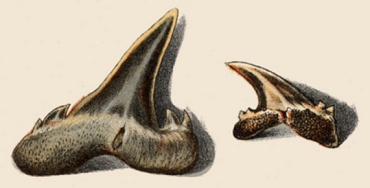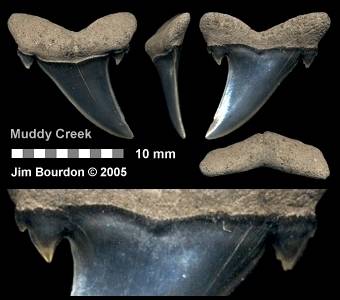| |
Winkler erected this taxon based on eleven teeth from the Bruxellian ( = Lutétien sub-stage) of Woluwe-Saint-Lambert, in Belgium; he wrote (translated PDS):
"I have found in the collection of Vincent a couple of teeth which belong without doubt to a new species of the genus Otodus. These teeth are characterized by a large root, not high, 'forming a very open angle'. The crown, rather large at its base, is getting abruptly thinner towards the point which is a little acute/sharp. The external crown face is more or less convex; the enamel possesses in the middle part of the crown base are longitudinal grooves, which doesn’t reach the top. The internal face is of course more convex than the external face, and is completely smooth. The cusplets are small and pointed ('making a very sharp angle'). Some of these teeth have present on each side of the crown two cusplets, one of them being smaller than the other: sometimes the small one is positioned on the base of the largest one, as being one cusp with two points. A couple of these teeth, especially the smallest ones, are curved, and are probably originating from the side of the fish's jaw."
 |
Fig. 1 - Otodus vincenti
Winlkler (1874) plate 1, fig. 9-10 |
"As I have said that I think these teeth have to be considered as a new species of the genus Otodus. After the fossil list with material found in the Bruxellian up to now, which I published in my previous memoir, we only encounter four species of the genus Otodus, being O. macrota Ag., O. microdon Ag., O. obliquus Ag. and O. minutissimus Winkl. The teeth we are speaking of at present can’t be ascribed to one of these four species."
Over the years, vincenti was generally used for teeth now ascribed to
Brachycarcharias and Hypotodus:
Woodward (1899) - Lamna vincenti
Leriche (1905, 06) - Lamna verticalis
Arambourg (1952) - Odontaspis vincenti
Baut & Genault (1995) - "Carcharias" vincenti
Cappetta & Nolf (2005) followed Leriche (1905, 06) who had included these teeth as Lamna verticalis; however, they reassigned them to the genus Hypotodus (JAEKEL, 1895).
For the most part, Hypotodus verticalis has a single cusplet on each shoulder; much less often a second reduced cusplet may be present. This observation has been noted in the Ypresian of North America (JB & SC) and Europe (PDS).
 |
Fig. 2 - Hypotodus verticalis
Ypresian, VA / USA |
Selected References
Agassiz, L. J. R. 1833-1844. Recherches sur les poissons fossiles. Text (5 vols; I., xlix+188 pp., II xii+310+366 pp., III viii+390 pp., IV xvi+296 pp., V xii+122+160 pp.) and Atlas (5 vols; I 10 pl., II., 149 pl., III 83 pl., IV, 61 pl., V, 91 pl.). Neuchâtel.
Cappetta, H & Nolf, D, 2005. Revision de quelques Odontaspidae (Neoselachii: Lamniformes) du Paleocene et de l'Eocene du Bassin de la mer du Nord Bulletin de l'institut Royal des Sciences Naturelles de Belgique, Sciences de la Terre 75:237-266.
Jaekel, O., 1895.Unter-Tertiäre Selachier aus Südrussland. Mémoires du Comité Géologique de Saint-Pétersbourg, 9: 19-35.
Leriche, M. 1905. Les Poissons Paléocènes de la Belgique. Mémoires du Musée Royale d'Histoire Naturelle de Belgique. Bruxelles. 33: 49-228.
Leriche, M. 1906. Contribution à l'étude des poissons fossiles du Nord de la France et des régions voisines. Mémoires de la Société géologique du Nord, 5: 1-430.
Winkler, T.C., 1874b. Deuxième mémoire sur des dents de poissons fossiles du terrain bruxellien. In: Archives du Musée Teyler, 1878; vol. IV (fasc. 1, 1876), pp 16-48; Extrait, 10 pages. Les Héritiers Loosjes, Haarlem, Belgium.
| |